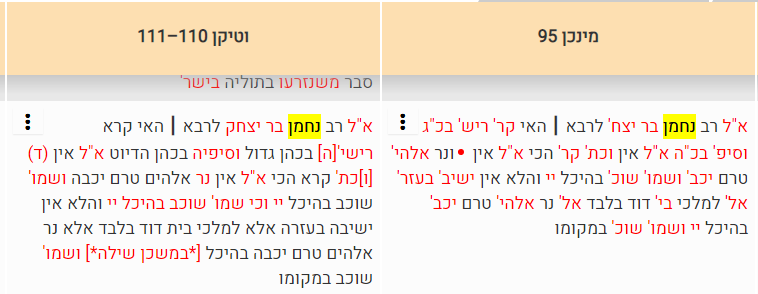Rav Nachman Inquires of his Student?
In today’s daf, Kiddushin 78a, transitioning to 78b, a slightly confusing exchange:
אֲמַר לֵיהּ רַב נַחְמָן לְרָבָא:
Rav Naḥman said to Rava:
הַאי קְרָא, רֵישָׁא בְּכֹהֵן גָּדוֹל וְסֵיפָא בְּכֹהֵן הֶדְיוֹט?! אֲמַר לֵיהּ: אִין.
Concerning this verse from Ezekiel, the first clause addresses a case with a High Priest, as it states that he may not marry a widow, and the latter clause addresses a case with a common priest, as it states that he may marry a widow. Is that a reasonable manner in which to interpret a verse? Rava said to him: Yes, that is the correct interpretation of the verse.
וּכְתַב קְרָא הָכִי? אֲמַר לֵיהּ: אִין, דִּכְתִיב: ״וְנֵר אֱלֹהִים טֶרֶם יִכְבֶּה וּשְׁמוּאֵל שֹׁכֵב בְּהֵיכַל ה׳״ – וַהֲלֹא אֵין יְשִׁיבָה בַּעֲזָרָה אֶלָּא לְמַלְכֵי בֵית דָּוִד בִּלְבַד! אֶלָּא: ״נֵר אֱלֹהִים טֶרֶם יִכְבֶּה״ – בְּהֵיכַל ה׳, ״וּשְׁמוּאֵל שֹׁכֵב״ – בִּמְקוֹמוֹ.
Rav Naḥman proceeded to ask: But can a verse be written in this way, addressing two different subjects without any demarcation? Rava said to him: Yes, and there is a similar case, as it is written: “And the lamp of God was not yet gone out, and Samuel was laid down to sleep in the Temple of the Lord” (I Samuel 3:3). If read literally, this verse is puzzling. It apparently states that Samuel was lying in the Sanctuary, but there is a right to sit in the courtyard of the Temple only for the kings of the house of David alone. How then could Samuel be laid down to sleep in the Temple? Rather, the verse should be understood as follows: “And the lamp of God was not yet gone out” in the Temple of the Lord, “and Samuel was laid down” in his place outside the Temple.
This is confusing because — despite some rare which might be interpreted to the contrary — plain Rav Nachman is third-generation Rav Nachman bar Yaakov, who is Rava’s teacher. Meanwhile, what is happening here is an inquiry, and that should be done by a student to a teacher, not a teacher to a student. I would expect this to be fifth-generation Rav Nachman bar Yitzchak, who is Rava’s student.
And indeed, it is a scribal error. The printings have plain Rav Nachman (thus, bar Yaakov):
One exception is the Guadalajara printing, which accurately has Rav Nachman bar Yitzchak:
The two manuscripts on Hachi Garsinan, namely Munich 95 and Vatican 110-111, also have the correct Rav Nachman bar Yitzchak.
How did Rav Nachman bar Yitzchak lose his patronymic and confuse Talmudic students in perpetuity? I would suggest that it is because of word wrap. Look again at the Guadalajara printing, which is the earliest of the bunch (ר”מ approximately). See how one line ends Rav Nachman and the next line begins Rava. If a scribe referred to this printing, he could easily skip the “bar Yitzchak”.
The Masoret HaShas in Artscroll, in a bracketed comment, made reference to manuscripts having “bar Yitzchak” and also noted the existing of a comment by Rashash.
Rashash’s comment is:
שם (בסה"ע) א"ל ר"נ לרבא כו'. לכאורה ה"נ להגיה איפכא רבא לר"נ. וי"ל הגי' שלפנינו דלא שאלהו אלא למיבדקי' (כדאיתא בירושלמי בפ"ט דתרומות הביאו גה"ש בב"מ (צ ב) ועמש"כ שם) והשיבו אין ושאלו עוד וכתב קרא הכי והשיבו אין וכו' ואתקיף ליה מכהן יקחו כו' אלא ע"כ פירושו משאר כהנים יקחו וא"כ הקרא גופי' מפרש דלאו בכה"ג משתעי. ורש"י בנימוקיו ליחזקאל הביא פי' זה וסיים עליו מצאתי ותמוה. ואולי הוא מדברי המעתיק ור"ל שמצא זה בס"א בפרש"י. והגר"א ז"ל פי' שם כפשוטו דאלמנת כהן מותרין הן ליקח ותמוה וע"ש בפי' הרד"ק. וק"ק וכי תורה קמהדר וכדמקשינן בסנהדרין (פא). ואולי הוא ע"ד דאמרי' בעלמא פרשה שנאמרה ונשנית ל"נ אלא בשביל דבר שנתחדש בה:
That is, since he doesn’t know about that manuscripts have “bar Yitzchak”, and he is troubled about the weirdness of a teaching inquiring of his student, he proposes either:
flip it around so that Rava asks these questions to Rav Nachman. (In the lengthy exchange, it is just amar leih after the initial query.)
say that the teacher is quizzing his student, to see how well Rava can answer.
While looking at that Rashash, he points to an interesting thing — that even though Rashi here in Kiddushin explains the gemara explaining the derasha on Yechezkel, Rashi on the very verse in Yechezkel gives an identical explanation, appending at the end matzati — I have found. Thus:
כי אם בתולות. יקחו הכהנים הגדולים אבל יש מן הכהנים אשר יקחו את האלמנה כגון הדיוטין וזהו מכהן יקחו יש מן הכהן שמותרין באלמנה, מצאתי:
but...virgins may the High Priests take. But there are some priests who may take a widow, namely, the ordinary ones, and this is the meaning of “some of the priests may marry”; there are some priests who are permitted to marry a widow.
Why would Rashi say he “found” this somewhere instead of referring to the gemara, like he does on the next verse he explains, כך שנויה במ"ק, so is taught in Moed Katan?
Rather than saying that Rashi forgot the source, Rashash suggests convincingly that this may be the copyist’s words, noting that he found this in one Rashi manuscript.









